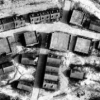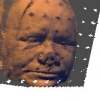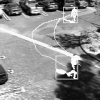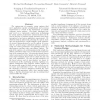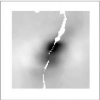CVPR
2000
IEEE
14 years 6 months ago
2000
IEEE
This paper investigates the use of colour and texture cues for segmentation of images within two specified domains. The first is the Sowerby dataset, which contains one hundred co...
CVPR
2000
IEEE
14 years 6 months ago
2000
IEEE
Machine perception can benefit from the use of features extracted from data provided by a variety of sensor modalities. Recent advances in sensor design makes it possible to incor...
CVPR
2000
IEEE
14 years 6 months ago
2000
IEEE
A sequence of images taken along a camera trajectory captures a subset of scene appearance. If visibility space is the space that encapsulates the appearance of the scene at every...
CVPR
2000
IEEE
14 years 6 months ago
2000
IEEE
The statistics of range images from natural environments is a largely unexplored eld of research. It closely relates to the statistical modeling of the scene geometry in natural e...
CVPR
2000
IEEE
14 years 6 months ago
2000
IEEE
Towards the goal of realizing a generic automatichuman activity recognition system, a new formalism is proposed. Activities are described by a chained hierarchical representation ...
CVPR
2000
IEEE
14 years 6 months ago
2000
IEEE
This paper examines the problem of image retrieval from large, heterogeneous image databases. We present a technique that fulfills several needs identified by surveying recent res...
CVPR
2000
IEEE
14 years 6 months ago
2000
IEEE
The quest for a vision system capable of representing and recognizing arbitrary motions benefits from a low dimensional, non-specific representation of flow fields, to be used in ...
CVPR
2000
IEEE
2000
IEEE
Statistical Modeling and Performance Characterization of a Real-Time Dual Camera Surveillance System
14 years 6 months ago
The engineering of computer vision systems that meet application speci c computational and accuracy requirements is crucial to the deployment of real-life computer vision systems....
CVPR
2000
IEEE
14 years 6 months ago
2000
IEEE
A novel algorithm for motion segmentation is proposed. The algorithm uses the fact that shape of an object with homogeneous motion is represented as 4 dimensional linear space. Th...
CVPR
2000
IEEE
14 years 6 months ago
2000
IEEE

